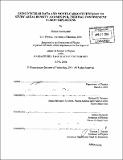| dc.contributor.advisor | Richard D. Petrasso and Miklos Porkolab. | en_US |
| dc.contributor.author | Kurebayashi, Shinya, 1976- | en_US |
| dc.contributor.other | Massachusetts Institute of Technology. Dept. of Physics. | en_US |
| dc.date.accessioned | 2005-10-14T20:07:57Z | |
| dc.date.available | 2005-10-14T20:07:57Z | |
| dc.date.copyright | 2004 | en_US |
| dc.date.issued | 2004 | en_US |
| dc.identifier.uri | http://hdl.handle.net/1721.1/29369 | |
| dc.description | Thesis (S.M.)--Massachusetts Institute of Technology, Dept. of Physics, 2004. | en_US |
| dc.description | Includes bibliographical references. | en_US |
| dc.description.abstract | Measurements from three classes of direct-drive implosions at the OMEGA laser system [T. R. Boehly et al., Opt. Commun. 133, 495 (1997)] were combined with Monte-Carlo simulations to investigate models for determining hot-fuel areal density ([rho]Rhot) in compressed, D2-filled capsules, and to assess the impact of mix and other factors on the determination of pRhot. The results of the Monte-Carlo calculations were compared to predictions of commonly used models that use ratios of either secondary D3He proton yields or secondary DT neutron yields to primary DD neutron yields to provide estimates [rho]Rhot or [rho]Rhot,n, respectively, for pRhot. For the first class of implosions, where [rho]Rhot is low (=/< 3 mg/cm2), [rho]Rhot,p and [rho]Rhot,n often agree with each other and are often good estimates of the actual [rho]Rhot. For the second class of implosions, where [rho]Rhot is of order 10 mg/cm2, pRhot,p often underestimates the actual value due to secondary proton yield saturation. In addition, fuel-shell mix causes pRhot,p to further underestimate, and [Rho]Rhot,n to overestimate, [rho]Rhot. As a result, values of [Rho]Rhot,p and [Rho]Rhot,n can be interpreted as lower and upper limits, respectively. For the third class of implosions, involving cryogenic capsules, secondary protons and neutrons are produced mainly in the hot and cold fuel regions, respectively, and the effects of the mixing of hot and cold fuel must be taken into account when interpreting the values of [rho]Rhot,p and pRhot,n. From these data sets, we conclude that accurate inference of [rho]Rhot requires comprehensive measurements in combination with detailed modeling. | en_US |
| dc.description.statementofresponsibility | by Shinya Kurebayashi. | en_US |
| dc.format.extent | 133 p. | en_US |
| dc.format.extent | 4378931 bytes | |
| dc.format.extent | 4378739 bytes | |
| dc.format.mimetype | application/pdf | |
| dc.format.mimetype | application/pdf | |
| dc.language.iso | eng | en_US |
| dc.publisher | Massachusetts Institute of Technology | en_US |
| dc.rights | M.I.T. theses are protected by copyright. They may be viewed from this source for any purpose, but reproduction or distribution in any format is prohibited without written permission. See provided URL for inquiries about permission. | en_US |
| dc.rights.uri | http://dspace.mit.edu/handle/1721.1/7582 | |
| dc.subject | Physics. | en_US |
| dc.title | Using Nuclear data and Monte-Carlo techniques to study areal density and mix in D² inertial confinement fusion implosions | en_US |
| dc.type | Thesis | en_US |
| dc.description.degree | S.M. | en_US |
| dc.contributor.department | Massachusetts Institute of Technology. Department of Physics | |
| dc.identifier.oclc | 56050800 | en_US |
